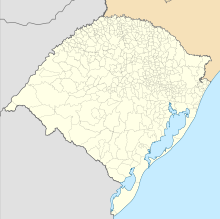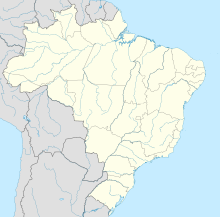
Summary
Pelotas–João Simões Lopes Neto International Airport (IATA: PET, ICAO: SBPK) is the airport serving Pelotas, Brazil.
Pelotas–João Simões Lopes Neto International Airport Aeroporto Internacional de Pelotas–João Simões Lopes Neto | |||||||||||||||
|---|---|---|---|---|---|---|---|---|---|---|---|---|---|---|---|
 | |||||||||||||||
| Summary | |||||||||||||||
| Airport type | Public | ||||||||||||||
| Operator | |||||||||||||||
| Serves | Pelotas | ||||||||||||||
| Time zone | BRT (UTC−03:00) | ||||||||||||||
| Elevation AMSL | 18 m / 59 ft | ||||||||||||||
| Coordinates | 31°42′58″S 052°19′52″W / 31.71611°S 52.33111°W | ||||||||||||||
| Website | www | ||||||||||||||
| Map | |||||||||||||||
 PET Location in Brazil  PET PET (Brazil) | |||||||||||||||
| Runways | |||||||||||||||
| |||||||||||||||
| Statistics (2023) | |||||||||||||||
| |||||||||||||||
This airport was named after the regional writer João Simões Lopes Neto (1865 — 1916).[5]
It is operated by CCR.
History edit
On June 22, 1927 the city of Pelotas received the first official commercial passenger flight operated by the first Brazilian airline, Varig, founded only a month earlier. The flight Porto Alegre/Pelotas/Rio Grande, operated by an amphibian Dornier Wal, used Pelotas River for landing and take-off operations. However, as early as 1930 a small terminal was built by a grass strip on the site where today is the airport.
In 1935 the airport with all the necessary amenities was officially inaugurated and continues in operation ever since.
In 1997 the whole airport complex was extensively renovated and a new terminal was opened in 1998. In 2001 it was upgraded to international status.
Previously operated by Infraero, on April 7, 2021 CCR won a 30-year concession to operate the airport.[6]
Pelotas is commonly used by the Brazilian Air Force as the last stop in Brazil on its flights to the Brazilian Antarctic Base.
Airlines and destinations edit
| Airlines | Destinations |
|---|---|
| Azul Brazilian Airlines | Porto Alegre Seasonal: Florianópolis |
| Gol Transportes Aéreos | São Paulo–Guarulhos |
| Voepass Linhas Aéreasa | Porto Alegre |
Note:
a: Flight operated with Voepass equipment on behalf of LATAM Brasil.
Accidents and incidents edit
- 11 January 1949: a SAVAG Lockheed Model 18-10-01 Lodestar registration PP-SAC flying from Pelotas to Porto Alegre crashed just after take-off from Pelotas killing all 8 occupants. Causes are likely to have been fuel contamination.[7]
- 12 April 1960: a Varig Douglas C-53 registration PP-CDS operating a flight for Cruzeiro do Sul from Pelotas to Porto Alegre collided with two other aircraft, crashed and caught fire after it deviated to the right on take-off and an over correction caused a sharp turn to the left. Of the 22 passengers and crew aboard, 10 died.[8][9]
Access edit
The airport is located 8 km (5 mi) from downtown Pelotas.
See also edit
References edit
- ^ "Movimentação aeroportuária". CCR (in Portuguese). Retrieved 26 February 2024.
- ^ "Pelotas". CCR Aeroportos (in Portuguese). Retrieved 31 May 2023.
- ^ "Aeródromos". ANAC (in Portuguese). 29 June 2020. Retrieved 25 April 2021.
- ^ "João Simões Lopes Neto (SBPK)". DECEA (in Portuguese). Retrieved 25 September 2023.
- ^ "Aeroporto de Pelotas passa a se chamar João Simões Lopes Neto". Agência Senado (in Portuguese). 12 March 2015. Retrieved 25 April 2021.
- ^ "Governo federal arrecada R$ 3,3 bilhões com leilão de 22 aeroportos". Agência Brasil (in Portuguese). Retrieved 7 April 2021.
- ^ "Accident description PP-SAC". Aviation Safety Network. Retrieved 24 May 2011.
- ^ "Accident description PP-CDS". Aviation Safety Network. Retrieved 24 May 2011.
- ^ Germano da Silva, Carlos Ari César (2008). "Decolagem sinuosa". O rastro da bruxa: história da aviação comercial brasileira no século XX através dos seus acidentes 1928–1996 (in Portuguese) (2 ed.). Porto Alegre: EDIPUCRS. pp. 187–189. ISBN 978-85-7430-760-2.
External links edit
- Airport information for SBPK at Great Circle Mapper. Source: DAFIF (effective October 2006).
- Current weather for SBPK at NOAA/NWS
- Accident history for PET at Aviation Safety Network


